Preliminary Design and Analysis of Supersonic Business Jet Engines
Abstract
:1. Introduction
2. Materials and Methods
2.1. Reference Aircraft and Missions
2.2. Engine Cycle Design
2.3. Preliminary Engine Design
2.3.1. Principal Modeling Structure and Capability
2.3.2. Fan-Section-Related Preliminary Design Tool Changes
2.3.3. Low-Pressure-Turbine-Related Preliminary Design Tool Changes
2.3.4. Application to the Study
3. Results
3.1. Engine Cycle Analysis
3.2. Effects on Aircraft Performance
3.3. Fan Section Studies
3.4. Low-Pressure Turbine Studies
4. Discussion
Author Contributions
Funding
Institutional Review Board Statement
Informed Consent Statement
Data Availability Statement
Acknowledgments
Conflicts of Interest
References
- Welge, H.; Nelson, C.; Bonet, J. Supersonic Vehicle Systems for the 2020 to 2035 Timeframe. In Proceedings of the 28th AIAA Applied Aerodynamics Conference, Chicago, IL, USA, 28 June–1 July 2010. AIAA 2010-4930. [Google Scholar]
- Liebhardt, B.; Lütjens, K. An Analysis of the Market Environment for Supersonic Business Jets. In Proceedings of the 60 Deutscher Luft-und Raumfahrtkongress, DLRK 2011-1457, Bremen, Deutschland, 27–29 September 2011. [Google Scholar]
- Henne, P.A. Case for Small Supersonic Civil Aircraft. J. Aircr. 2005, 42, 765–774. [Google Scholar] [CrossRef]
- Sun, Y.; Smith, H. Review and prospect of supersonic business jet design. Prog. Aerosp. Sci. 2017, 90, 12–38. [Google Scholar] [CrossRef]
- Hartbrich, I. Die Akustikprobleme der neuen Überschallflugzeuge. In VDI Nachrichten; VDI Verlag GmbH: Düsseldorf, Germany, 2021. [Google Scholar]
- Schlette, T.; Staudacher, S. Engine Design Requirements for Supersonic Business Jets. In Proceedings of the 14th European Conference on Turbomachinery Fluid Dynamics and Thermodynamics, Gdansk, Poland, 12–16 April 2021. [Google Scholar]
- Berton, J.J.; Haller, W.J.; Senick, P.F.; Jones, S.M.; Seidel, J.A. A Comparative Propulsion System Analysis for the High-Speed Civil Transport; NASA TM-2005-213414; NASA Glenn Research Center: Cleveland, OH, USA, 2005. [Google Scholar]
- Morgenstern, J.; Norstrud, N.; Stelmack, M.; Skoch, C. Final Report for the Advanced Concept Studies for Supersonic Commercial Transports Entering Service in the 2030 to 2035 Period, N+3 Supersonic Program; NASA CR-2010-216796; NASA Glenn Research Center: Cleveland, OH, USA, 2010. [Google Scholar]
- Nordqvist, M.; Kareliusson, J.; da Silva, E.R.; Kyprianidis, K. Conceptual Design of a Turbofan Engine for a Supersonic Business Jet. In Proceedings of the International Symposium on Air Breathing Engines, ISABE 2017, Manchester, UK, 3–8 September 2017; pp. 2580–2597. [Google Scholar]
- Korovkin, V.; Evstigneev, A.; Makarov, V.; Strelets, D.; Shevelev, O.; Kopiev, V.; Belyaev, I. Concept of Prototype of Near-Term Supersonic Commercial Aircraft with Derivative Engines Based on Existing Cores. In Proceedings of the ISABE 2019, Canberra, Australia, 22–27 September 2019. [Google Scholar]
- Verstraete, D. Multi-objective Optimisation of a Turbofan for a Supersonic Transport Aircraft. In Proceedings of the ISABE 2019, Canberra, Australia, 22–27 September 2019. [Google Scholar]
- Mirzoyan, A.; Mirzoyan, L. Studies on Required Performances of Advanced Supersonic Civil Aircraft and Their Propulsion Systems for 2020–2035 Timeframe. In Proceedings of the ICAS 2012, Brisbane, Australia, 23–28 September 2012. [Google Scholar]
- Rodriguez, D. Propulsion/Airframe Integration and Optimization on a Supersonic Business Jet. In Proceedings of the 45th AIAA Aerospace Sciences Meeting and Exhibit, Reno, NV, USA, 8–11 January 2007. [Google Scholar]
- Berens, T. Aerodynamic Propulsion Integration for Supersonic Business Jets. In Proceedings of the 46th AIAA/ASME/SAE/ASEE Joint Propulsion Conference & Exhibit, Nashville, TN, USA, 25–28 July 2010; American Institute of Aeronautics and Astronautics: Reston, VA, USA, 2010. [Google Scholar]
- Garzon, A. Use of a Translating Cowl on a SSBJ for Improved Takeoff Performance. In Proceedings of the 45th AIAA Aerospace Sciences Meeting and Exhibit, Reno, NV, USA, 8–11 January 2007. [Google Scholar]
- Slater, J.W. Design and Analysis Tool for External-Compression Supersonic Inlets. In Proceedings of the 50th AIAA Aerospace Sciences Meeting Including the New Horizons Forum and Aerospace Exposition, Nashville, TN, USA, 9–12 January 2012. [Google Scholar]
- Lytle, J.K. The Numerical Propulsion System Simulation: An Overview; NASA TM-2000-209915; NASA Glenn Research Center: Cleveland, OH, USA, 2000. [Google Scholar]
- Onat, E.; Klees, G.W. A Method to Estimate Weight and Dimensions of Large and Small Gas Turbines; NASA CR-159481; NASA Glenn Research Center: Cleveland, OH, USA, 1979. [Google Scholar]
- Tong, M.T.; Naylor, B.A. An Object-Oriented Computer Code for Aircraft Engine Weight Estimation. In Proceedings of the ASME Turbo Expo 2008: Power for Land, Sea, and Air, Berlin, Germany, 9–13 June 2008; Volume 1, pp. 1–7. [Google Scholar]
- Grönstedt, T. Development of Methods for Analysis and Optimization of Complex Jet Engine Systems. Ph.D. Thesis, Chalmers University of Technology, Göteborg, Sweden, 2000. [Google Scholar]
- Grönstedt, T.; Au, D.; Kyprianidis, K.; Ogaji, S. Low-Pressure System Component Advancements and Its Influence on Future Turbofan Engine Emissions. In Proceedings of the ASME Turbo Expo 2009: Power for Land, Sea, and Air, Orlando, FL, USA, 8–12 June 2009; Volume 4, pp. 505–516. [Google Scholar] [CrossRef]
- Arago, O.; Bretschneider, S.; Staudacher, S. A Unit Cost Comparison Methodology for Turbofan Engines. In Proceedings of the ASME Turbo Expo 2007: Power for Land, Sea, and Air, Montreal, QC, Canada, 14–17 May 2007; Volume 1, pp. 81–86. [Google Scholar]
- Kyprianidis, K. Multi-disciplinary conceptual design of future jet engine systems. Ph.D. Thesis, Cranfield University, Bedfordshire, UK, 2010. [Google Scholar]
- Thoma, E.M.; Grönstedt, T.; Zhao, X. Quantifying the Environmental Design Trades for a State-of-the-Art Turbofan Engine. Aerospace 2020, 7, 148. [Google Scholar] [CrossRef]
- MacMillan, W.L. Development of a Modular-Type Computer Program for the Calculation of Gas Turbine Off-Design Performance. Ph.D. Thesis, Cranfield University, Bedfordshire, UK, 1974. [Google Scholar]
- Bala, A.; Sethi, V.; Gatto, E.L.; Pachidis, V.; Pilidis, P. A Collaborative Venture for Gas Turbine Performance Simulation using an Object Oriented Programming Schema. In Proceedings of the ISABE 2007, Beijing, China, 2–7 September 2007. [Google Scholar]
- Alexiou, A.; Aretakis, N.; Kolias, I.; Mathioudakis, K. Novel Aero-Engine Multi-Disciplinary Preliminary Design Optimization Framework Accounting for Dynamic System Operation and Aircraft Mission Performance. Aerospace 2021, 8, 49. [Google Scholar] [CrossRef]
- Visser, W.P.J. Generic Analysis Methods for Gas Turbine Engine Performance. Ph.D. Thesis, Delft University of Technology, Delft, The Netherlands, 2015. [Google Scholar]
- Reitenbach, S.; Vieweg, M.; Becker, R.; Hollmann, C.; Wolters, F.; Schmeink, J.; Otten, T.; Siggel, M. Collaborative Aircraft Engine Preliminary Design Using a Virtual Engine Platform, Part A. In Proceedings of the AIAA Scitech 2020 Forum, Orlando, FL, USA, 6–10 January 2020. [Google Scholar]
- Kirby, M.R.; Marvis, D.N. The Environmental Design Space. In Proceedings of the ICAS 2008, Anchorage, AK, USA, 14–19 September 2008. [Google Scholar]
- Proesmans, P.J. Preliminary Propulsion System Design and Integration for a Box-Wing Aircraft Configuration: A Knowledge Based Engineering Approach. Master’s Thesis, Delft University of Technology, Delft, The Netherlands, 2019. [Google Scholar]
- Jeschke, P.; Kurzke, J.; Schaber, R.; Riegler, C. Preliminary Gas Turbine Design Using the Multidisciplinary Design System MOPEDS. J. Eng. Gas Turbines Power 2004, 126, 258–264. [Google Scholar] [CrossRef]
- Panchenko, Y.; Moustapha, H.; Mah, S.; Patel, K.; Dowhan, M.J.; Hall, D. Preliminary Multi-Disciplinary Optimization in Turbomachinery Design. In Proceedings of the RTO AVT Symposium, RTO-MP-089, Paris, France, 22–25 April 2002. [Google Scholar]
- Jones, M.J.; Bradbrook, S.J.; Nurney, K. A Preliminary Engine Design Process for an Affordable Capability. In Proceedings of the RTO AVT Symposium, RTO-MP-089, Paris, France, 22–25 April 2002. [Google Scholar]
- Kuz’michev, V.; Krupenich, I.; Filinov, E.; Ostapyuk, Y.; Koryanov, V.V.; Polyakova, M.; Yuan, H. Comparative Analysis of Mathematical Models for Turbofan Engine Weight Estimation. MATEC Web Conf. 2018, 220, 03012. [Google Scholar] [CrossRef]
- Lehmann, E.A. Multiple Application Core Engine. J. Aircr. 1980, 17, 802–809. [Google Scholar] [CrossRef]
- Buller, M.; Albrecht, G.; Rahman, A. The Design of a Common Core for the BR700 Family. SAE Trans. 1994, 103, 2077–2085. [Google Scholar]
- Bretschneider, S. Knowledge-Based Preliminary Design of Aero-Engine Gas-Generators. Ph.D. Thesis, Universität Stuttgart, Stuttgart, Germany, 2010. [Google Scholar]
- Lighthill, M.J. On sound generated aerodynamically. Proc. R. Soc. Lond. Ser. A Math. Phys. Sci. 1952, 211, 564–587. [Google Scholar]
- Smith, M.J.T. Aircraft Noise; Cambridge University Press: Cambridge, UK, 1989. [Google Scholar]
- Torenbeek, E. Synthesis of Subsonic Airplane Design; Delft University Press: Delft, The Netherlands, 1982. [Google Scholar]
- Raymer, D. Aircraft Design; American Institute of Aeronautics and Astronautics, Inc.: Washington, DC, USA, 2006. [Google Scholar]
- Nicolai, L.M.; Carichner, G.E. Fundamentals of Aircraft and Airship Design; Volume I—Aircraft Design; AIAA Education Series; AIAA American Institute of Aeronautics and Astronautics: Reston, VA, USA, 2010. [Google Scholar]
- Smith, H. A Review of Supersonic Business Jet Design Issues. Aeronaut. J. 2007, 111, 761–776. [Google Scholar] [CrossRef]
- Liebhardt, B.; Lütjens, K.; Tracy, R.R.; Haas, A.O. Exploring the Prospect of Small Supersonic Airliners—A Case Study Based on the Aerion AS2 Jet. In Proceedings of the 17th AIAA Aviation Technology, Integration, and Operations Conference, Denver, CO, USA, 5–9 June 2017. [Google Scholar]
- Bons, N.; Martins, J.R.R.A.; Mader, C.A.; McMullen, M.; Suen, M. High-fidelity Aerostructural Optimization Studies of the Aerion AS2 Supersonic Business Jet. In Proceedings of the AIAA Aviation 2020 Forum, Virtual Event, 15–19 June 2020. [Google Scholar]
- Harris, R.V.J. An Analysis and Correlation of Aircraft Wave Drag; NASA TM X-947; NASA Langley Research Center: Hampton, VA, USA, 1964. [Google Scholar]
- Harris, R.V.J. A Numerical Technique for Analysis of Wave Drag at Lifting Conditions; NASA-TN-D-3586; NASA Langley Research Center: Hampton, VA, USA, 1966. [Google Scholar]
- Grieb, H. Projektierung von Turboflugtriebwerken; Birkhäuser Basel: Basel, Switzerland, 2004. [Google Scholar]
- Grieb, H. Verdichter für Turbo-Flugtriebwerke; Springer: Berlin/Heidelberg, Germany, 2009. [Google Scholar]
- Kaplan, B.; Nicke, E.; Voss, C. Design of a Highly Efficient Low-Noise Fan for Ultra-High Bypass Engines. In Proceedings of the ASME Turbo Expo 2006, Barcelona, Spain, 6–11 May 2006. GT2006-90363. [Google Scholar]
- Kurzke, J.; Halliwell, I. Propulsion and Power; Springer International Publishing: Cham, Switzerland, 2018. [Google Scholar]
- Fullagar, K.P.L.; Broomfield, R.W.; Hulands, M.; Harris, K.; Erickson, G.L.; Sikkenga, S.L. Aero Engine Test Experience With CMSX-4® Alloy Single-Crystal Turbine Blades. J. Eng. Gas Turbines Power 1996, 118, 380–388. [Google Scholar]
- Horst, O.M.; Adler, D.; Git, P.; Wang, H.; Streitberger, J.; Holtkamp, M.; Jöns, N.; Singer, R.F.; Körner, C.; Eggeler, G. Exploring the fundamentals of Ni-based superalloy single crystal (SX) alloy design. Mater. Des. 2020, 195, 108976. [Google Scholar] [CrossRef]
- Bürgel, R.; Maier, H.J.; Niendorf, T. Handbuch Hochtemperatur-Werkstofftechnik, 4th ed.; Vieweg+Teubner Verlag/Springer Fachmedien Wiesbaden GmbH: Wiesbaden, Germany, 2011. [Google Scholar]
- Mattingly, J.D.; Heiser, W.H.; Pratt, D.T. Aircraft Engine Design, 2nd ed.; American Institute of Aeronautics and Astronautics: Reston, VA, USA, 2004. [Google Scholar]
- Fleming, W. Internal Performance of Several Types of Jet-exit Configurations for Supersonic Turbojet Aircraft; NACA-RM-E52K04; NASA Glenn Research Center: Cleveland, OH, USA, 1953. [Google Scholar]
- Krull, H.G.; Steffen, F.W. Performance Characteristics of One Convergent and Three Convergent-Divergent Nozzles; NACA-RM-E52H12; NASA Glenn Research Center: Cleveland, OH, USA, 1952. [Google Scholar]
- Münzberg, H.G. Flugantriebe; Springer: Berlin/Heidelberg, Germany, 1972. [Google Scholar]
- Walsh, P.P.; Fletcher, P. Gas Turbine Performance, 2nd ed.; Blackwell Science: Oxford, UK, 2008. [Google Scholar]
- Zobel, O. Datenmodell zur Vorauslegung moderner Wide-Chord-Fans mit Booster in Pacelab. Master’s Thesis, Universität Stuttgart, Stuttgart, Germany, 2008. [Google Scholar]
- Bürkle, M. Erweiterung eines Datenmodells zur automatisierten Vorauslegung von Fans für zivile Luftfahrtantriebe mit hohem Nebenstromverhältnis. Master’s Thesis, Universität Stuttgart, Stuttgart, Germany, 2012. [Google Scholar]
- Donus, F.; Schaber, R.; Schmidt, K.J.; Staudacher, S. Accuracy of Analytical Engine Weight Estimation During the Conceptual Design Phase. In Proceedings of the ASME Turbo Expo 2010: Power for Land, Sea, and Air, Glasgow, UK, 14–18 June 2010; Volume 6, pp. 1377–1384. [Google Scholar]
- Staudacher, S. Untersuchungen zum sekundären Luftsystem von Luftstrahltriebwerken. Ph.D. Thesis, Technische Universität München, München, Germany, 1995. [Google Scholar]
- Schlüter, R. Konstruktive Auslegung des Hochdruckverdichters von zivilen Flugtriebwerken der 25000 lbf-Schubklasse. Master’s Thesis, Universität Stuttgart, Stuttgart, Germany, 2006. [Google Scholar]
- Smith, S.F. A Simple Correlation of Turbine Efficiency. J. R. Aeronaut. Soc. 1965, 69, 467–470. [Google Scholar] [CrossRef]
- Cumpsty, N.A. Compressor Aerodynamics, reprint ed; Krieger Publishing Company: Malabar, FL, USA, 2004. [Google Scholar]
- Wu, C.H.; Wolfenstein, L. Application of Radial Equilibrium Condition to Axial-Flow Compressor and Turbine Design; NACA-TR-955; NASA Glenn Research Center: Cleveland, OH, USA, 1950. [Google Scholar]
- Wilson, D.G.; Korakianitis, T. The Design of High-Efficiency Turbomachinery and Gas Turbines, 2nd ed.; MIT: Cambridge, MA, USA; London, UK, 2014. [Google Scholar]
- Jung, M. Erstellung eines Vorauslegungstools für die Beschaufelung von axialen Hochdruckverdichtern für zivile Luftfahrtantriebe in der Entwicklungsumgebung Pacelab. Master’s Thesis, Universität Stuttgart, Stuttgart, Germany, 2007. [Google Scholar]
- Saravanamuttoo, H.I.H.; Cohen, H.; Rogers, G.F.C. Gas Turbine Theory, 5th ed.; Prentice Hall: Harlow, UK, 2001. [Google Scholar]
- Glassman, A.J. Computer Program for Preliminary Design Analysis of Axial-Flow Turbines; NASA-TN-D-6702; NASA Glenn Research Center: Cleveland, OH, USA, 1972. [Google Scholar]
- Dixon, S.L. Fluid Mechanics and Thermodynamics of Turbomachinery, 4th ed.; Butterworth-Heinemann: Boston, MA, USA, 1998. [Google Scholar]
- Crippa, M. Vorauslegungstool für die Beschaufelung von axialen NDT. Master’s Thesis, Universität Stuttgart, Stuttgart, Germany, 2007. [Google Scholar]
- Kacker, S.C.; Okapuu, U. A Mean Line Prediction Method for Axial Flow Turbine Efficiency. J. Eng. Power 1982, 104, 111–119. [Google Scholar] [CrossRef]
- Craig, H.R.M.; Cox, H.J.A. Performance Estimation of Axial Flow Turbines. Proc. Inst. Mech. Eng. 1970, 185, 407–424. [Google Scholar] [CrossRef]
- Peters, M.; Schmidt, T.; Jeschke, P. Influence of Blade Aspect Ratio on Axial Compressor Efficiency. J. Glob. Power Propuls. Soc. 2019, 3, 639–652. [Google Scholar] [CrossRef]
- Malzacher, F.J.; Gier, J.; Lippl, F. Aerodesign and Testing of an Aeromechanically Highly Loaded LP Turbine. J. Turbomach. 2006, 128, 643–649. [Google Scholar] [CrossRef]
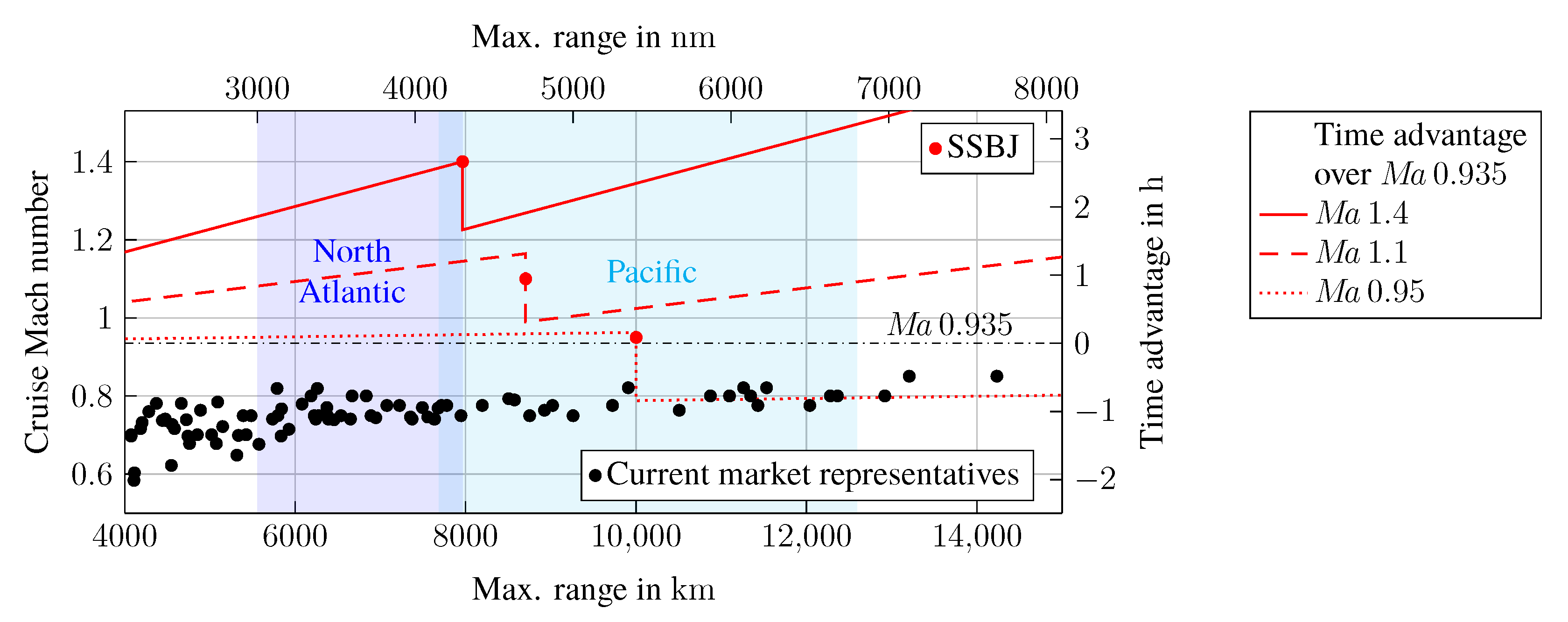
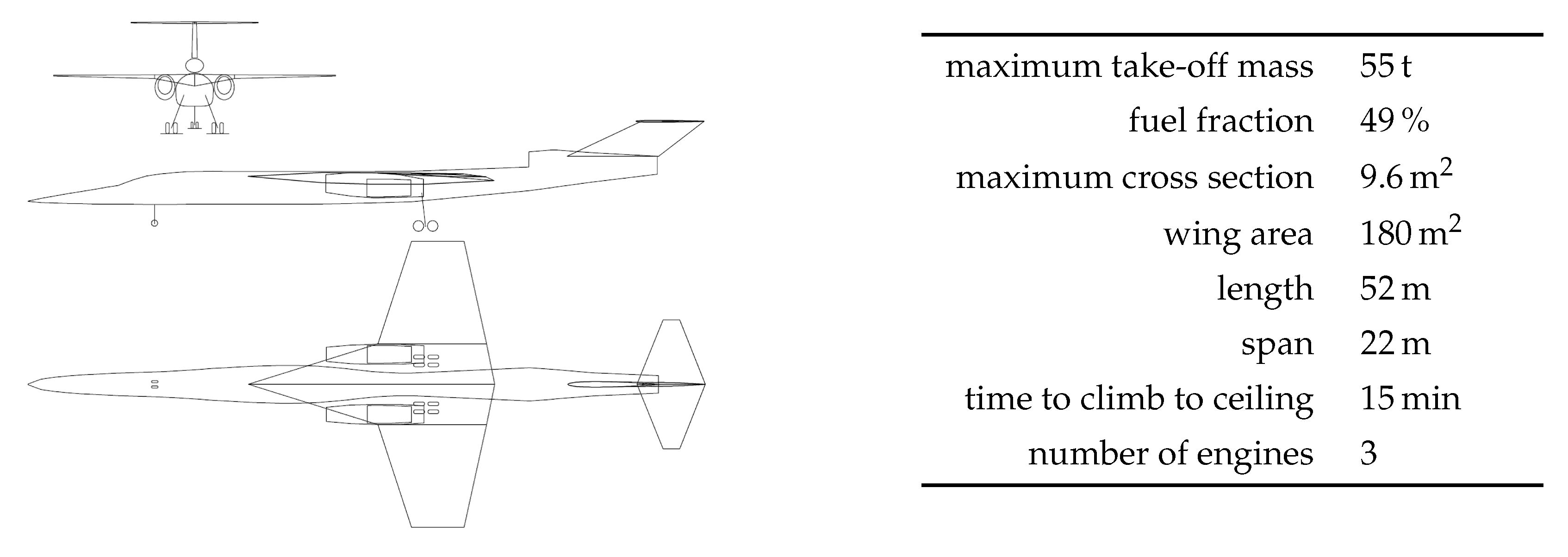

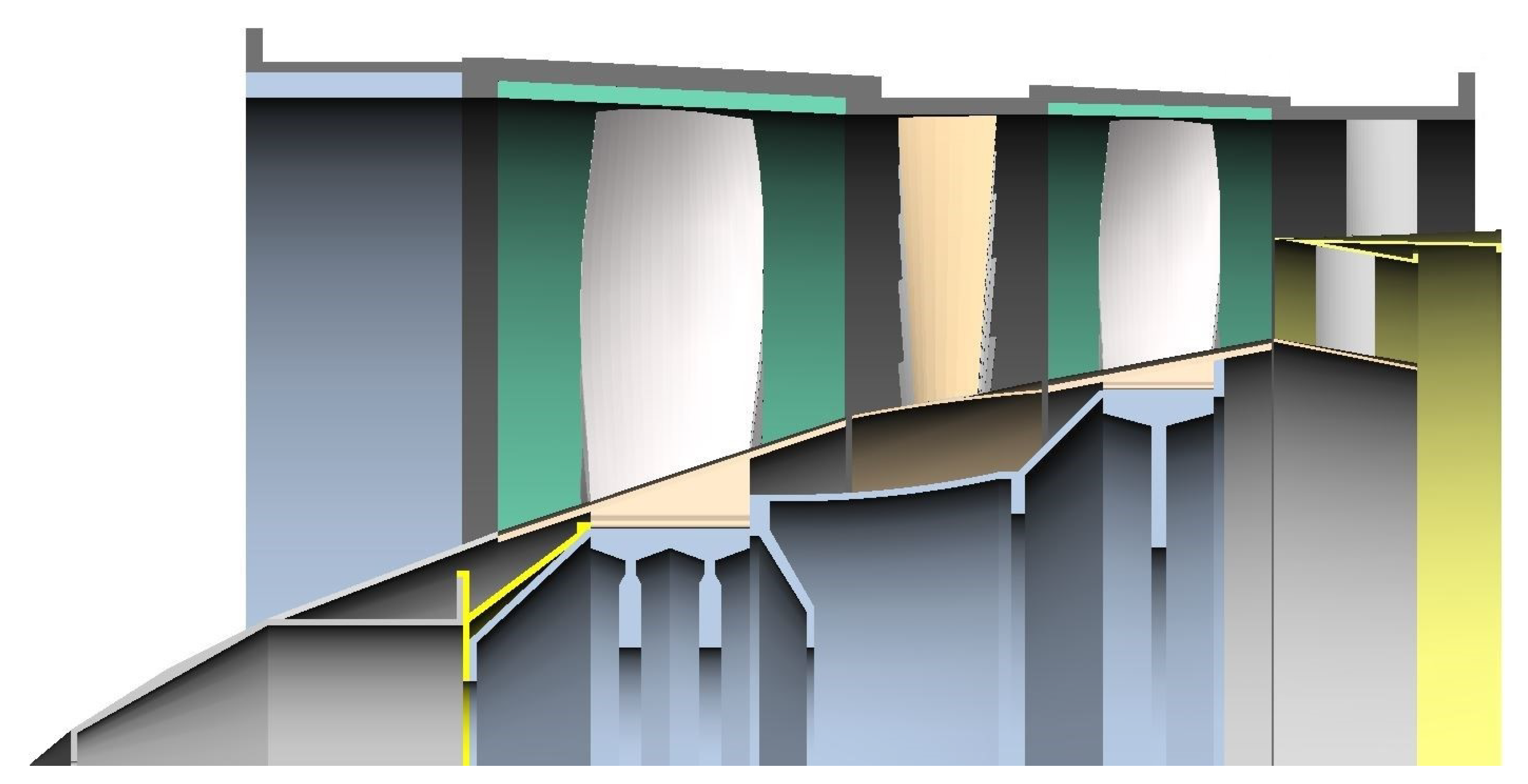

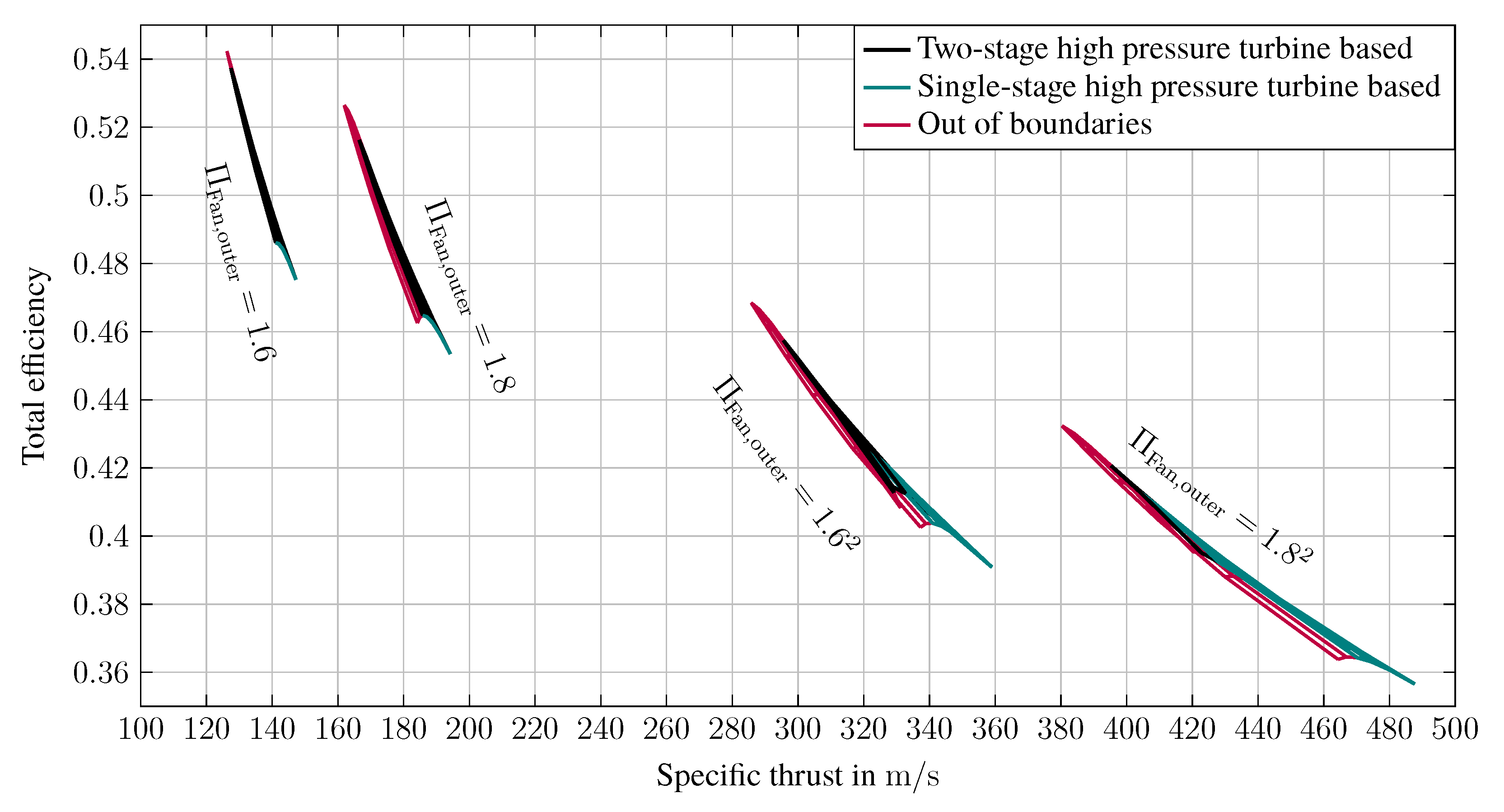
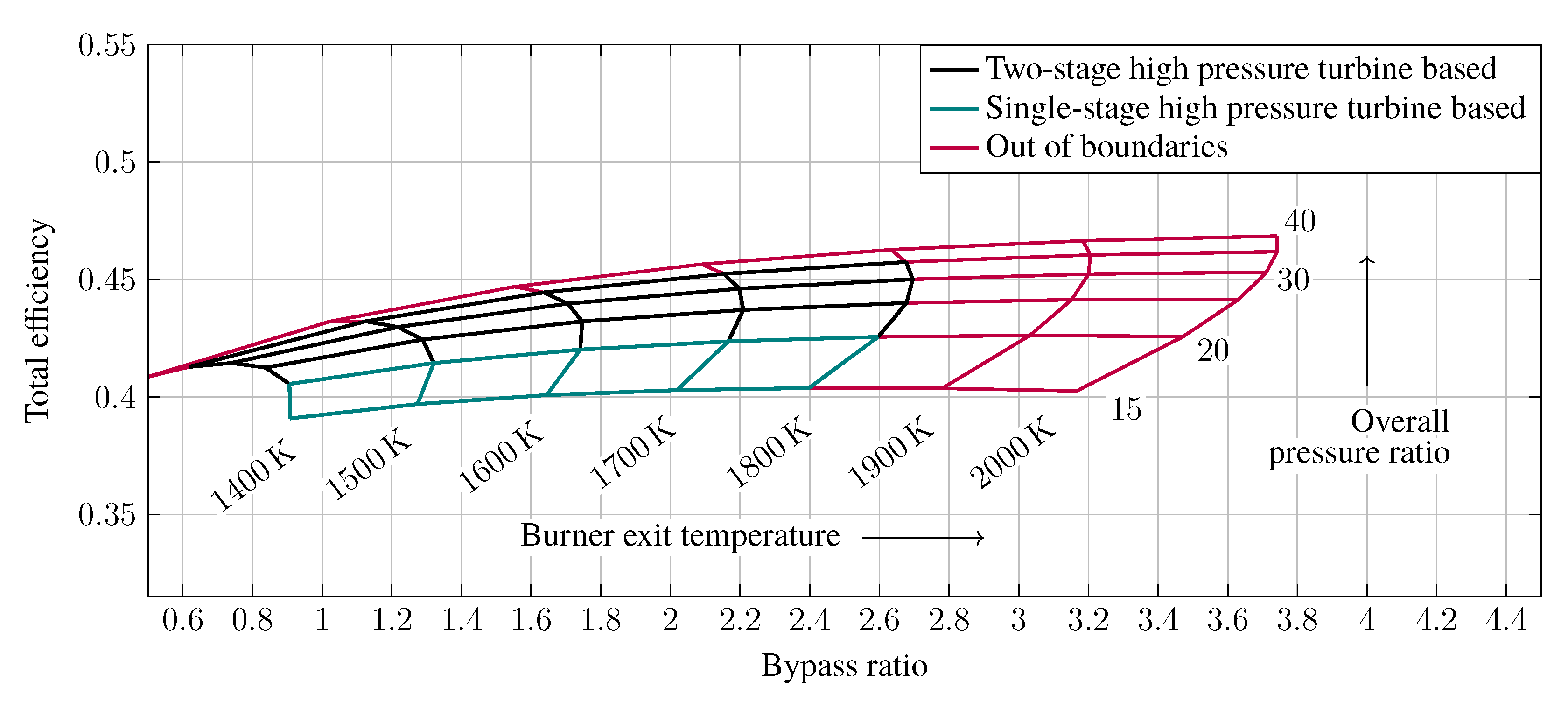
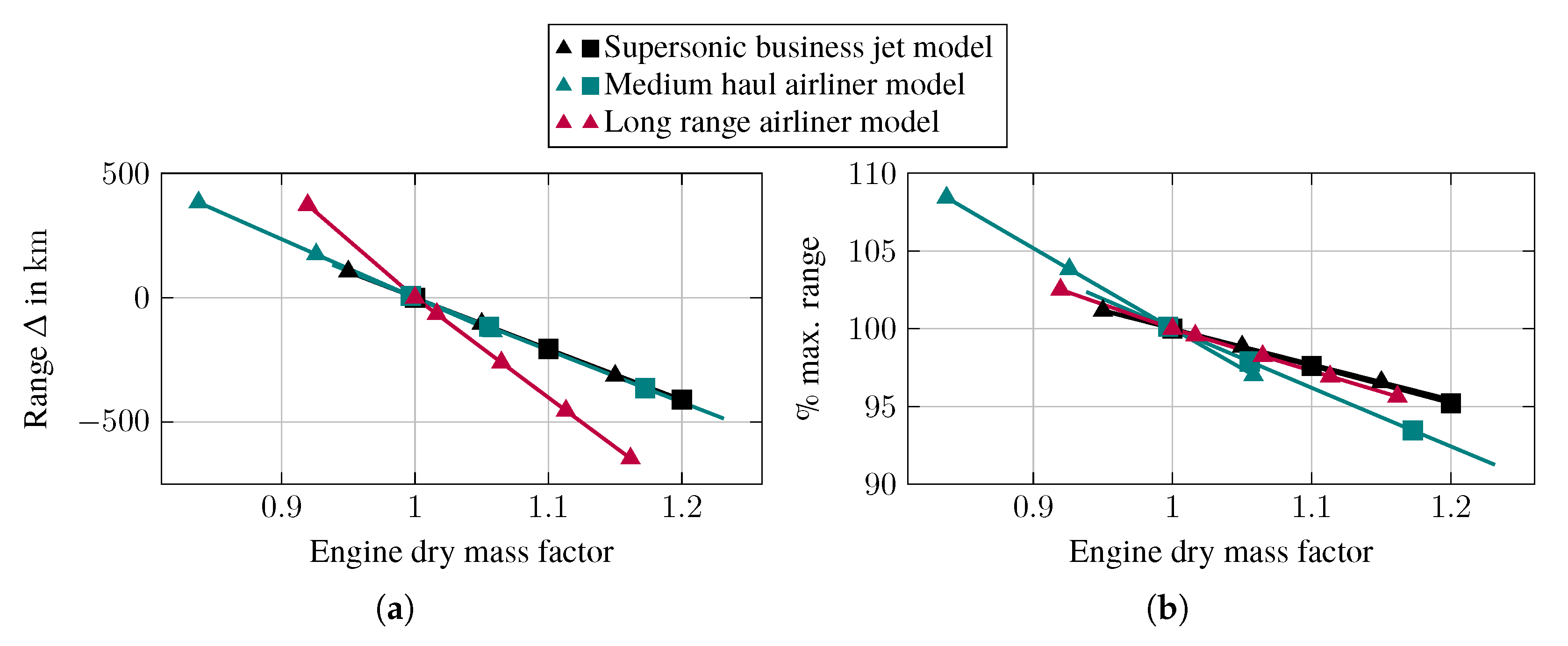

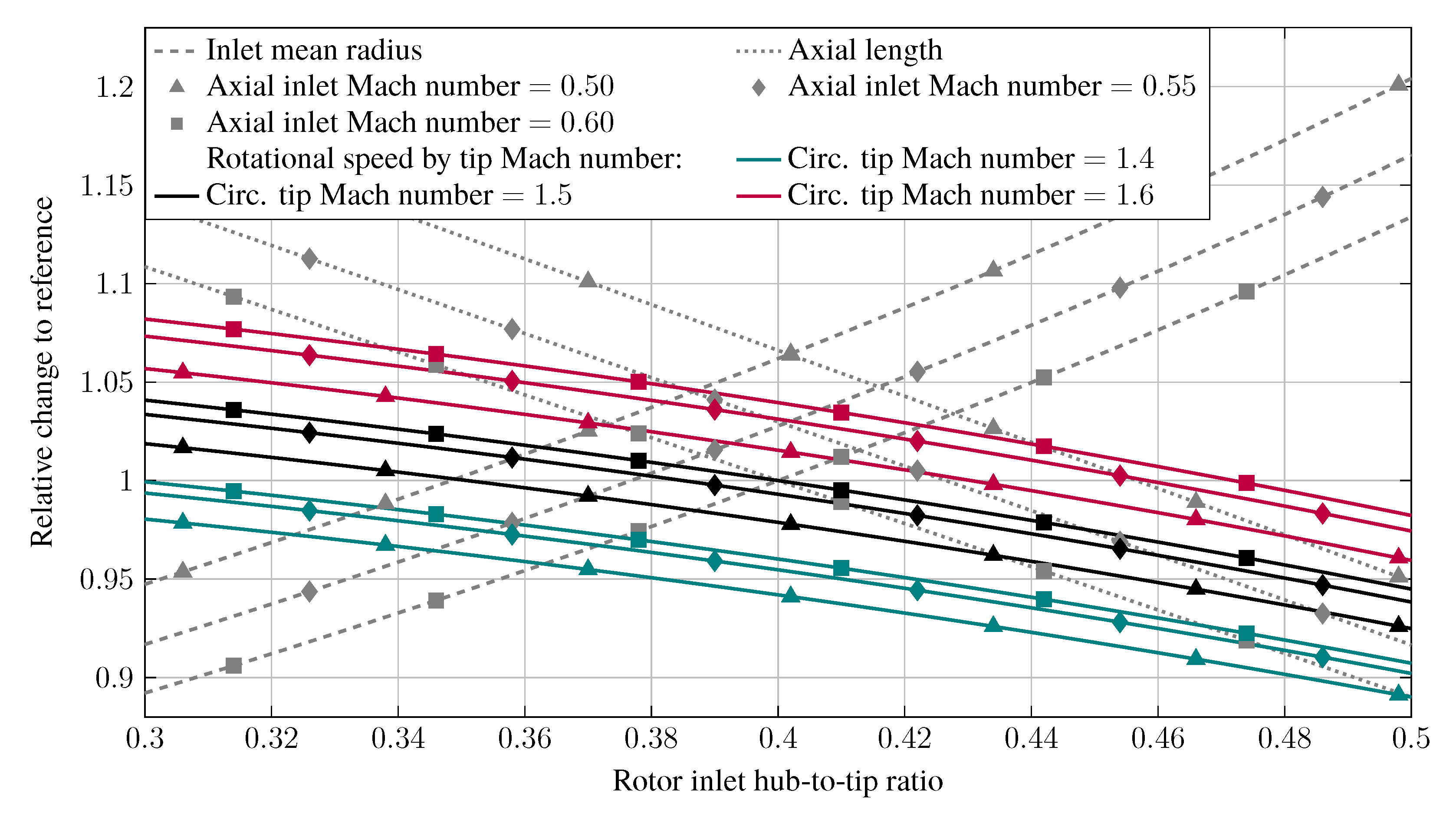

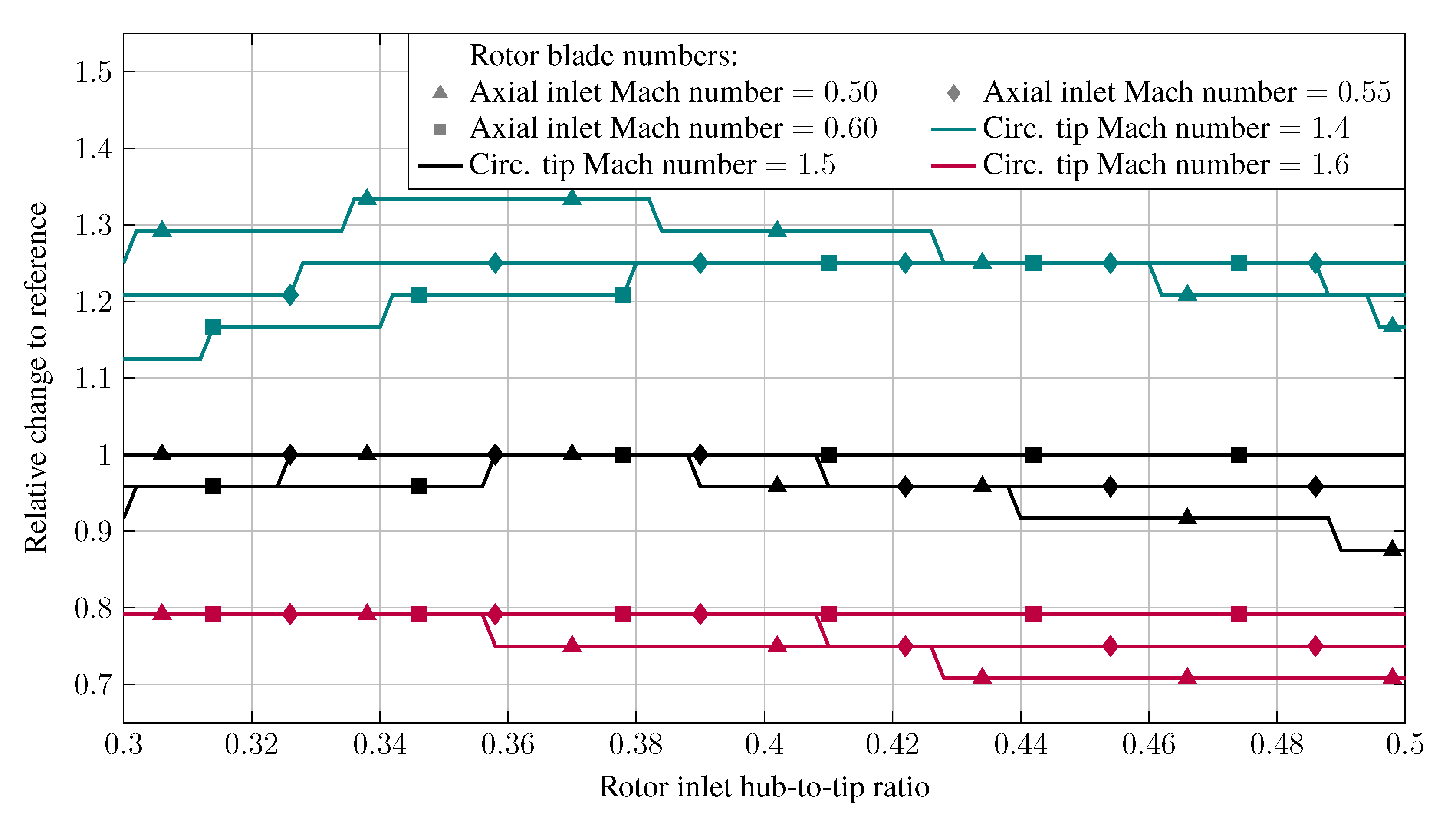



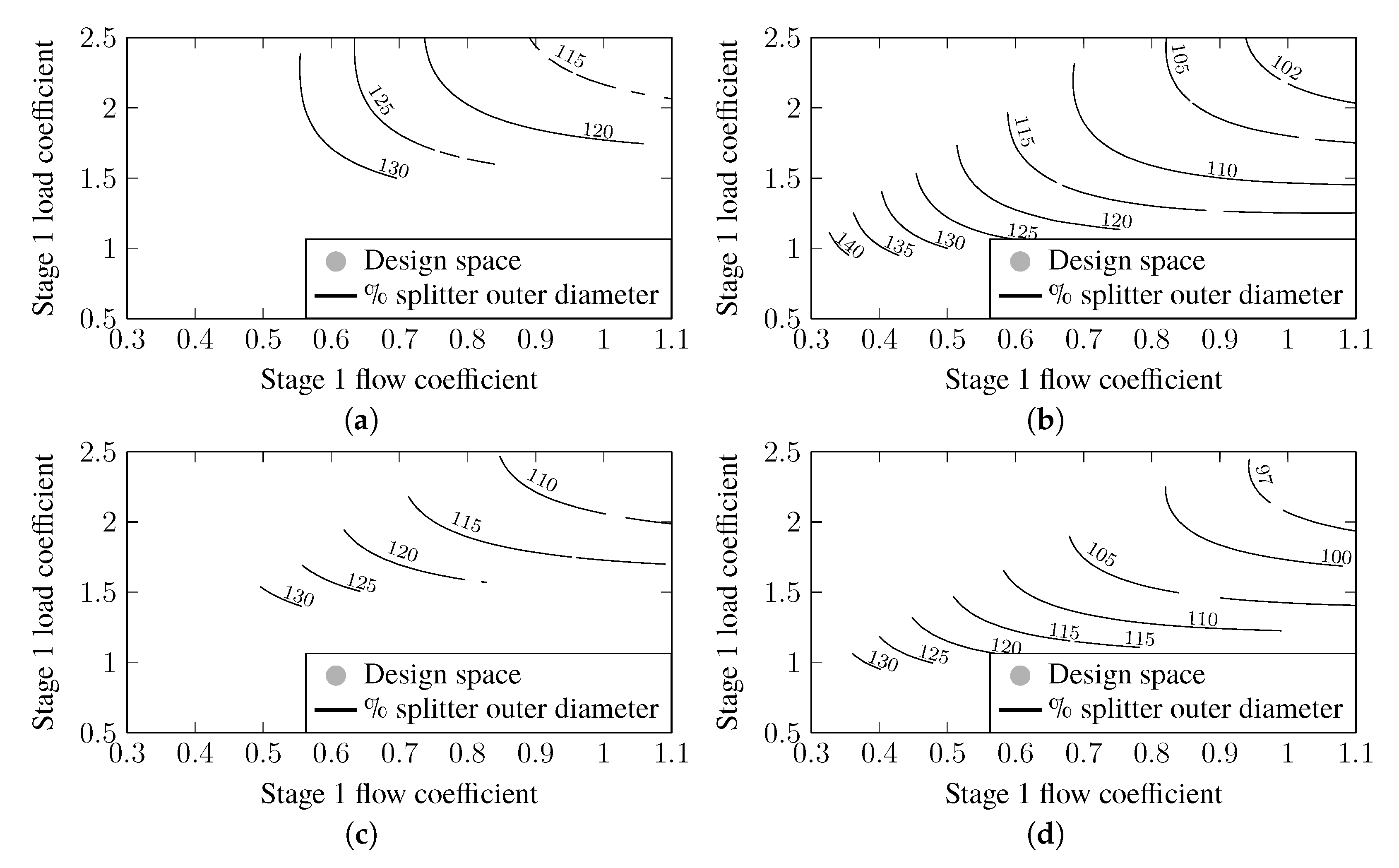
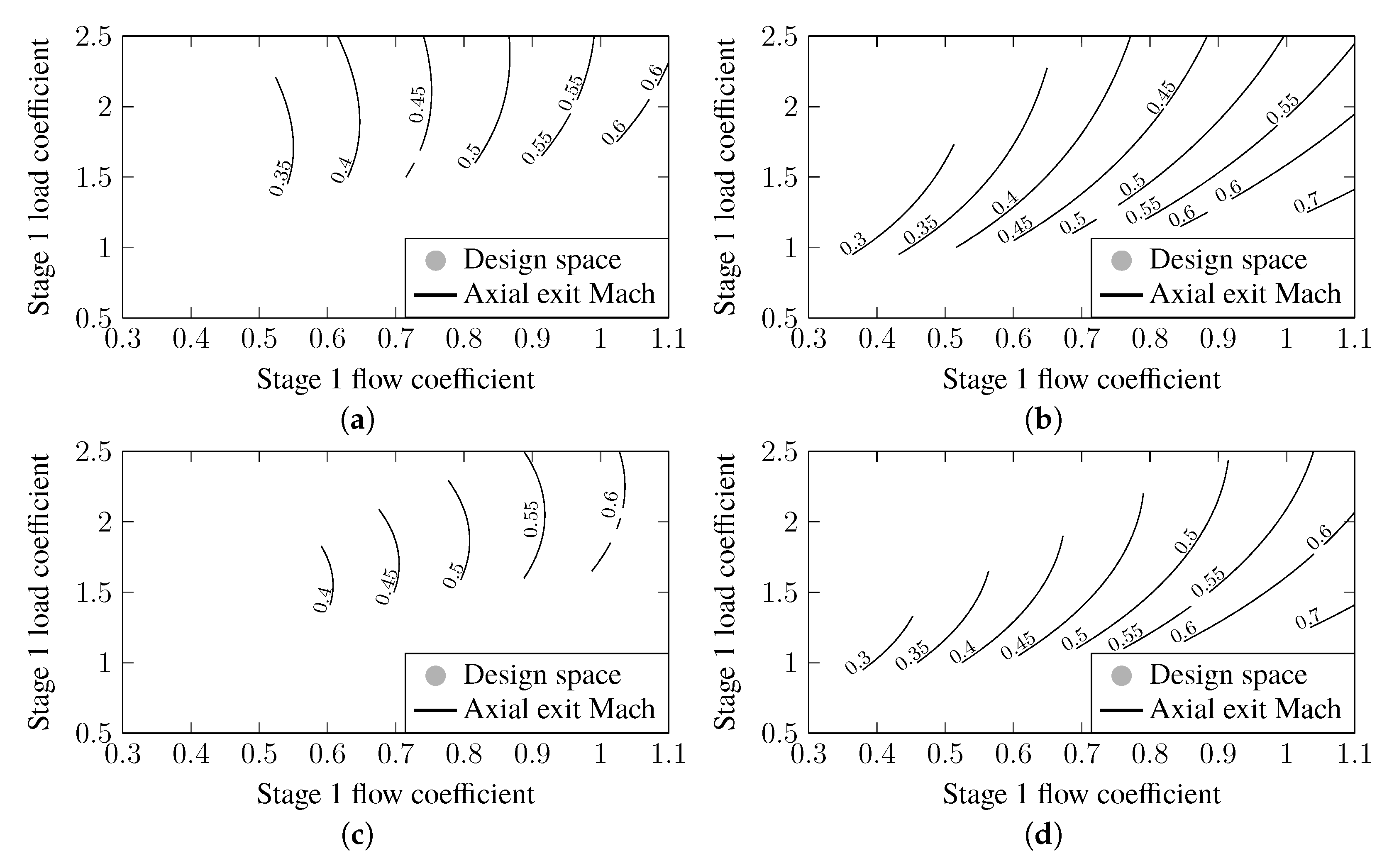

| Stage Parameter | Unit | Value |
|---|---|---|
| pressure ratio | – | |
| polytropic efficiency | – | |
| total inlet pressure | 60 | |
| total inlet temperature | 302 | |
| inlet mass flow | ||
| inlet hub-to-tip ratio | – | |
| tip speed | 451 | |
| circumferential tip Mach number | – | |
| axial inlet Mach number | – |
| Turbine Parameter | Unit | Value |
|---|---|---|
| polytropic efficiency | – | |
| total inlet pressure | 288 | |
| total inlet temperature | 1324 | |
| inlet mass flow | ||
| rotational speed | 11,000 | |
| first-stage load coefficient | – | |
| first-stage flow coefficient | – |
Publisher’s Note: MDPI stays neutral with regard to jurisdictional claims in published maps and institutional affiliations. |
© 2022 by the authors. Licensee MDPI, Basel, Switzerland. This article is an open access article distributed under the terms and conditions of the Creative Commons Attribution (CC BY) license (https://creativecommons.org/licenses/by/4.0/).
Share and Cite
Schlette, T.; Staudacher, S. Preliminary Design and Analysis of Supersonic Business Jet Engines. Aerospace 2022, 9, 493. https://doi.org/10.3390/aerospace9090493
Schlette T, Staudacher S. Preliminary Design and Analysis of Supersonic Business Jet Engines. Aerospace. 2022; 9(9):493. https://doi.org/10.3390/aerospace9090493
Chicago/Turabian StyleSchlette, Timo, and Stephan Staudacher. 2022. "Preliminary Design and Analysis of Supersonic Business Jet Engines" Aerospace 9, no. 9: 493. https://doi.org/10.3390/aerospace9090493
APA StyleSchlette, T., & Staudacher, S. (2022). Preliminary Design and Analysis of Supersonic Business Jet Engines. Aerospace, 9(9), 493. https://doi.org/10.3390/aerospace9090493








